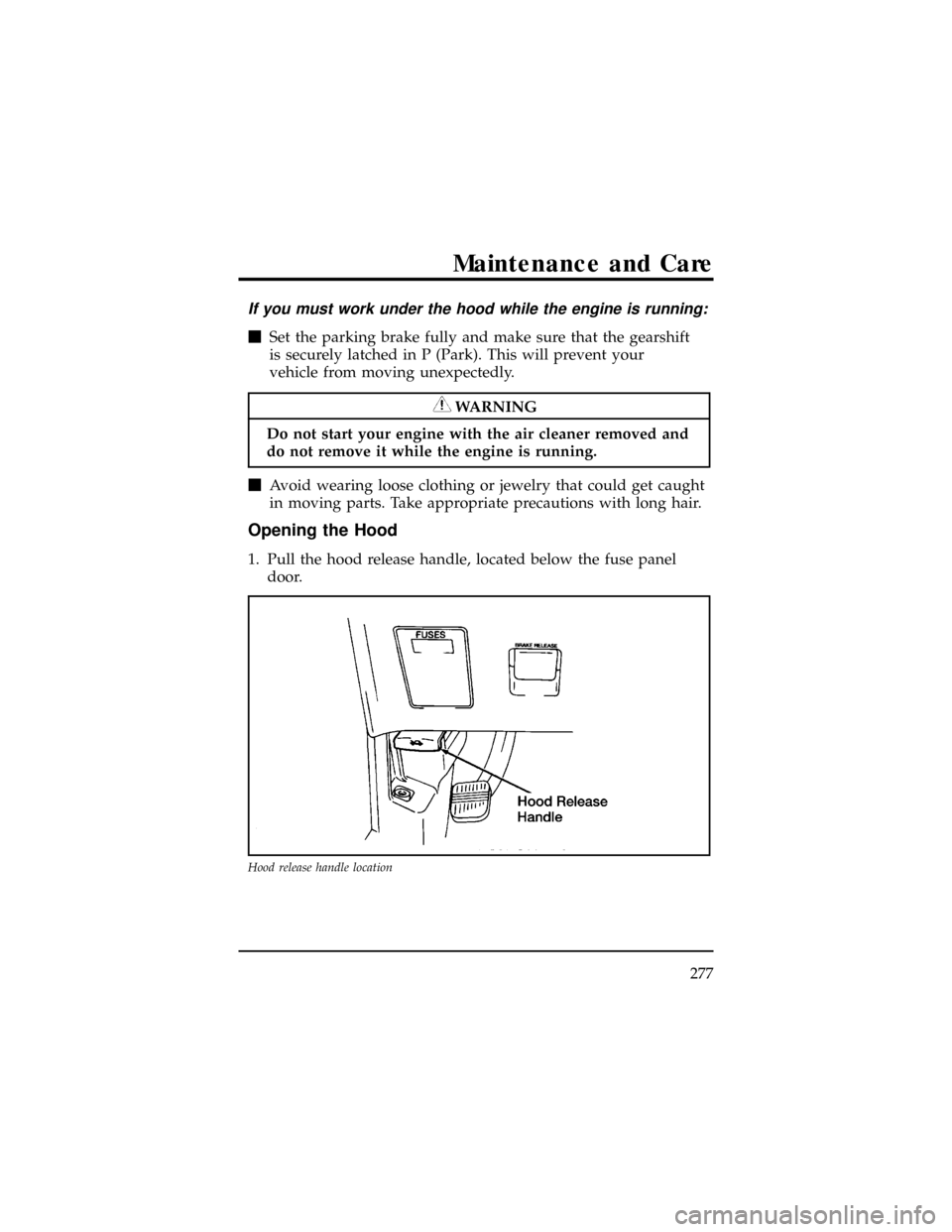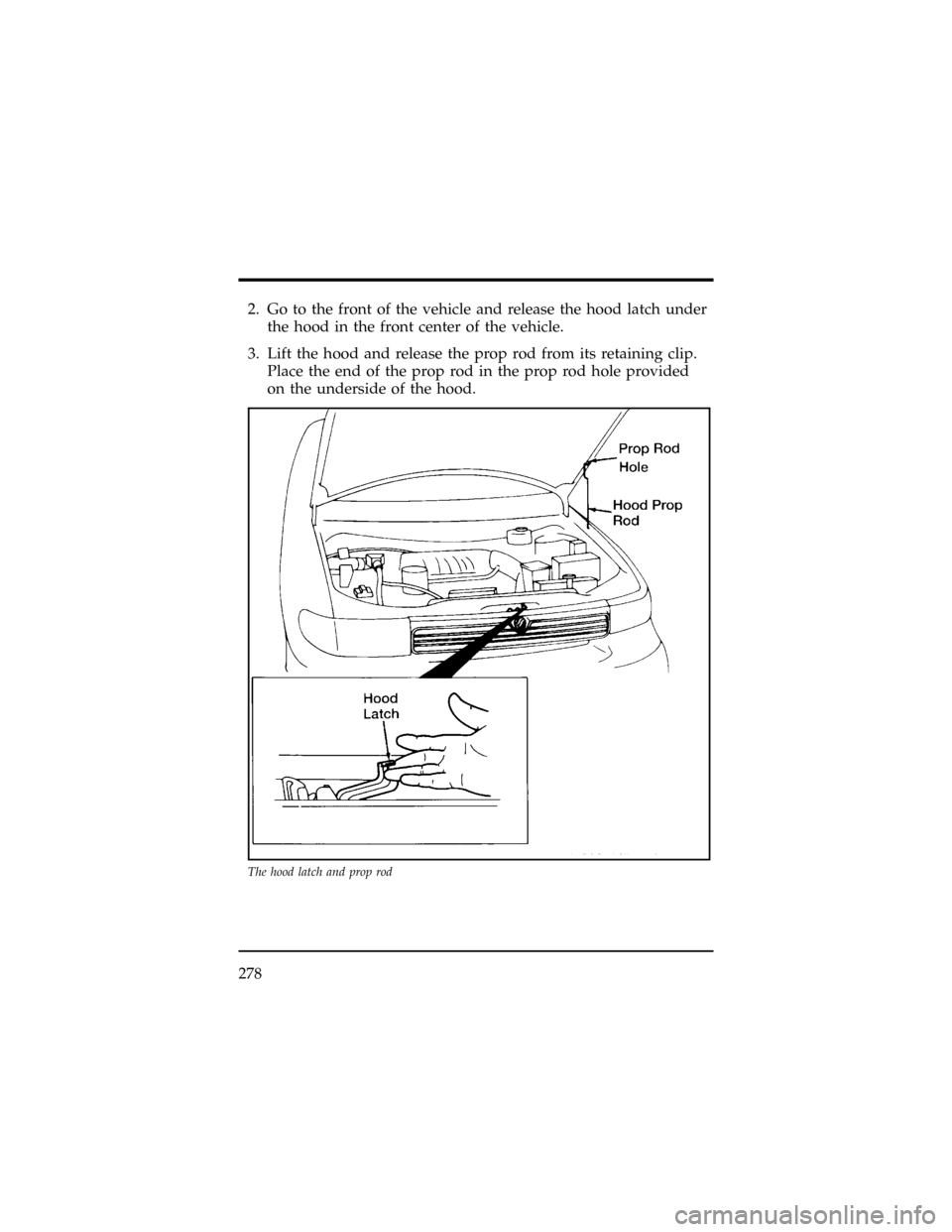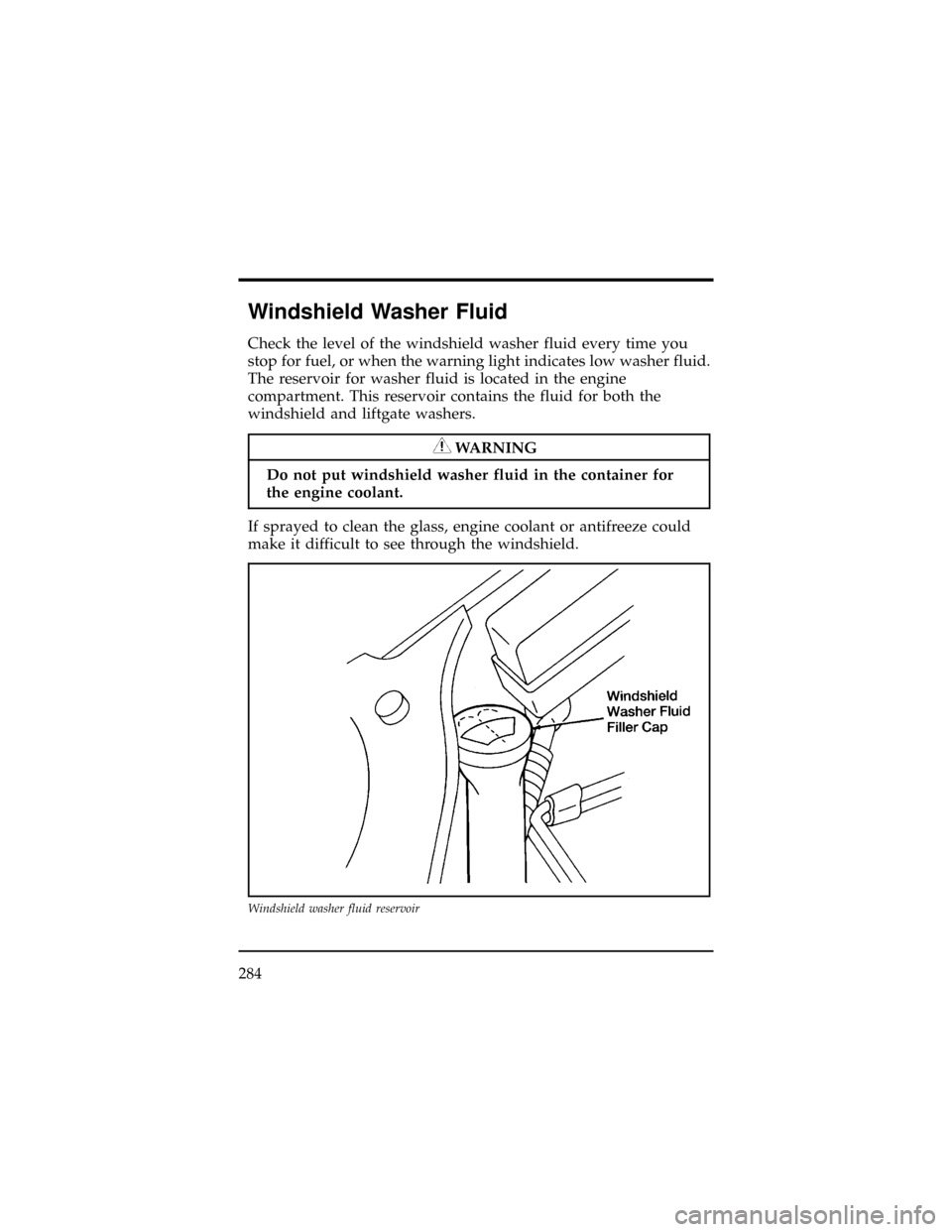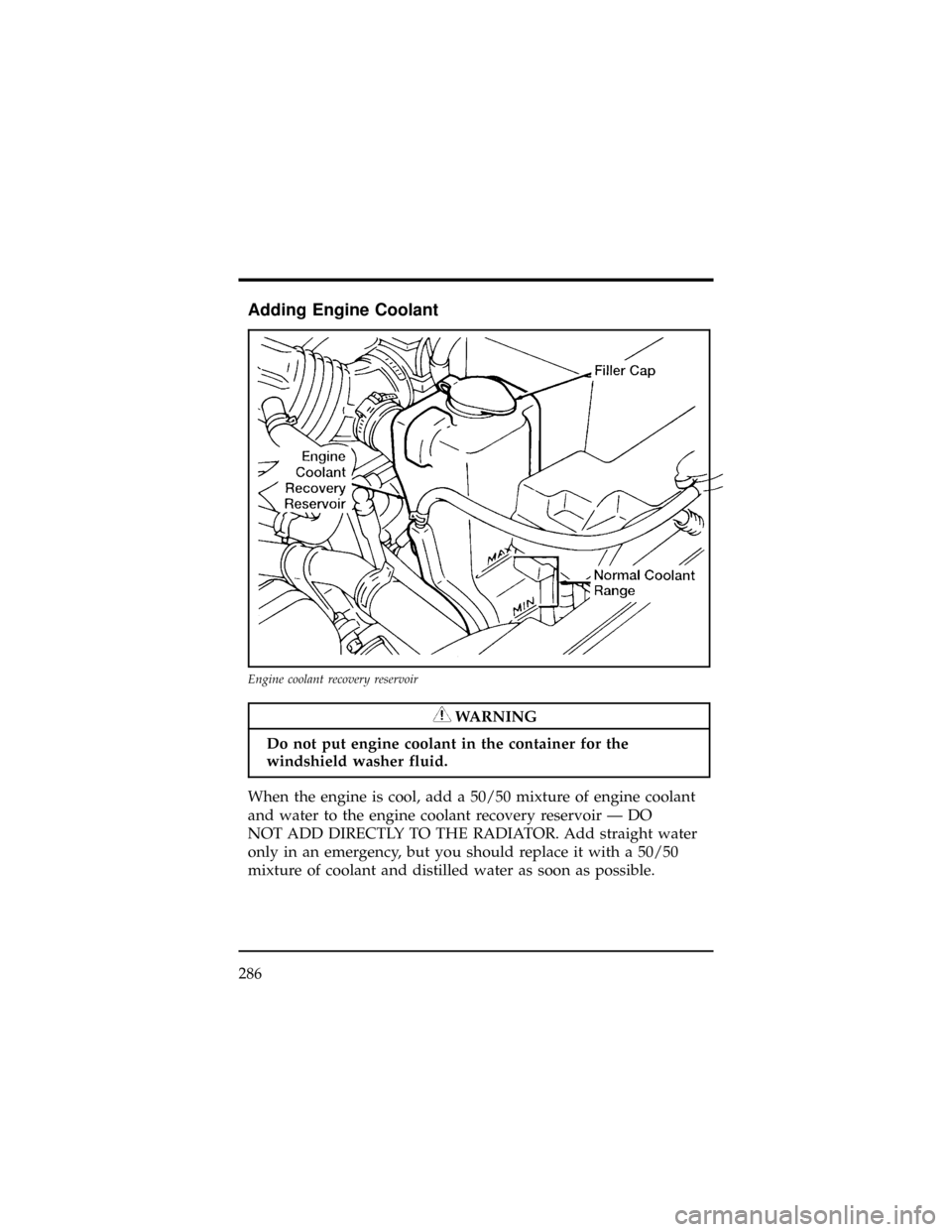Mercury Villager 1998 Owner's Manuals
Manufacturer: MERCURY, Model Year: 1998, Model line: Villager, Model: Mercury Villager 1998Pages: 400, PDF Size: 2.06 MB
Page 281 of 400

If you must work under the hood while the engine is running:
mSet the parking brake fully and make sure that the gearshift
is securely latched in P (Park). This will prevent your
vehicle from moving unexpectedly.
WARNING
Do not start your engine with the air cleaner removed and
do not remove it while the engine is running.
mAvoid wearing loose clothing or jewelry that could get caught
in moving parts. Take appropriate precautions with long hair.
Opening the Hood
1. Pull the hood release handle, located below the fuse panel
door.
Hood release handle location
Maintenance and Care
277
Page 282 of 400

2. Go to the front of the vehicle and release the hood latch under
the hood in the front center of the vehicle.
3. Lift the hood and release the prop rod from its retaining clip.
Place the end of the prop rod in the prop rod hole provided
on the underside of the hood.
The hood latch and prop rod
278
Page 283 of 400

To close the hood:
1. Remove the prop rod from the slotted hole in the hood. Place
the rod in its retaining clip and close the hood with enough
force to make it latch. Be sure to oil the hood latch every six
months to maintain smooth operation.
2. Try to lift the hood after closing it to be sure it is securely
latched.
Engine Oil Recommendations
Ford oil specification is WSS-M2C153-G.
Use SAE 5W-30 motor oil certified for gasoline engines by the
American Petroleum Institute.
Do not use supplemental engine oil additives, oil treatments or
engine treatments. They are unnecessary and could, under certain
conditions, lead to engine damage which is not covered by
your warranty.
Maintenance and Care
279
Page 284 of 400

Checking Engine Oil
Check the engine oil each time you fuel your vehicle.
1. Make sure the vehicle is on level ground.
2. Turn the engine off and wait a few minutes for the oil to drain
into the oil pan.
3. Set the parking brake and ensure the gearshift is securely
latched in Park,9P9.
4. Open the hood. Protect yourself from engine heat.
5. Locate and carefully remove the engine oil level indicator (dip
stick).
6. Wipe the indicator clean. Insert the indicator fully, then
remove it again.
mIf the oil level isbetween the L and H marks,the oil level is
acceptable.DO NOT ADD OIL
mIf the level is below the L mark, add enough oil to raise the
level within the L-H range
WARNING
Oil level above the H mark may cause engine damage.
Some oil must be removed from the engine by a service
technician.
7. Put the indicator back in and ensure it is fully seated.
280
Page 285 of 400

Changing the Engine Oil and the Oil Filter
Refer to theMaintenance Schedulebooklet for additional
information.
Follow these directions to change the engine oil and oil filter:
1. Turn the engine off after it has warmed up.
2. Protect yourself from engine heat and the engine oil being
drained.
3. Remove the oil pan drain plug(s)andoil filter.
4. Drain the oil into a container until flow from the drain plug
hole(s) and the filter mounting area slows to a drip.
5. Install the drain plug(s) and a new engine oil filter according
to directions on the package.
NOTE: SeeRefill Capacities, Motorcraft Parts and Lubrication
Specificationsin theCapacities and Specificationschapter
for the appropriate oil filter and engine oil refill quantity.
6. Remove the engine oil dipstick (highlighted in yellow) to
prevent oil contamination of the engine ventilating system while
refilling.
Engine oil dipstick
Maintenance and Care
281
Page 286 of 400

7. Refill the engine with a CERTIFIED engine oil of the preferred
viscosity. Start the engine and check for leaks. Follow
directions inChecking and adding engine oilto be sure the
engine is filled to the proper level.
WARNING
Continuous contact with USED motor oil has caused
cancer in laboratory mice.
Protect your skin by washing with soap and water.
Brake Fluid
Your vehicle is equipped with a brake fluid level indicator in the
master cylinder which lights the BRAKE warning light on the
instrument panel when the brake fluid level is low.
Under normal circumstances, your vehicle should not use up
brake fluid rapidly. However, expect the level of the brake fluid
to slowly fall as you put more mileage on your vehicle and
the brake pads wear.
Check the brake fluid at least once a year. You can do this by
looking at the fluid level in the plastic brake fluid reservoir on the
master cylinder. The fluid level should be at or near the MAX
mark.
WARNING
Brake fluid is toxic.
If brake fluid contacts eyes, flush eyes with running water for 15
minutes. Get medical attention if irritation persists. If taken
internally, drink water and induce vomiting. Get medical attention
immediately.
282
Page 287 of 400

If the fluid is low, carefully clean and remove the filler cap from
the reservoir. Fill the reservoir to the MAX line with Ford
High Performance DOT 3 Brake Fluid C6AZ-19542-AB or DOT 3
equivalent fluid meeting Ford specification ESA-M6C25-A.
WARNING
If you use a brake fluid that is not DOT 3, you will cause
permanent damage to your brakes.
Do not fill the reservoir above the MAX line.
If you find that the fluid level is excessively low Ð below the
seam or ridge on the outside of the plastic reservoir Ð have the
brake system inspected.
WARNING
Do not let the reservoir for the master cylinder run dry.
This may cause the brakes to fail.
Brake fluid master cylinder reservoir
Maintenance and Care
283
Page 288 of 400

Windshield Washer Fluid
Check the level of the windshield washer fluid every time you
stop for fuel, or when the warning light indicates low washer fluid.
The reservoir for washer fluid is located in the engine
compartment. This reservoir contains the fluid for both the
windshield and liftgate washers.
WARNING
Do not put windshield washer fluid in the container for
the engine coolant.
If sprayed to clean the glass, engine coolant or antifreeze could
make it difficult to see through the windshield.
Windshield washer fluid reservoir
284
Page 289 of 400

Use specially formulated windshield washer fluid rather than
plain water, because specially formulated washer fluids contain
additives that dissolve road grime. For safety reasons,
washer fluids containing an appropriate antifreeze such as
methanol should be used in freezing weather (temperatures below
32É F [0É C]). State or local regulations on Volatile Organic
Compounds (VOCs) may restrict use of the most common
antifreeze, methanol. Washer fluids containing non-methanol
antifreeze agents should be used only if they provide cold weather
protection without damaging the vehicle's paint finish, wiper
blades, and windshield washer system.
Engine Coolant
Checking the Engine Coolant
NOTE: Be sure to read and understandPrecautions When
Servicing Your Vehicleat the beginning of this chapter.
Your vehicle's engine coolant protects the engine from overheating
in the summer and from freezing in the winter. Check the level
of the engine coolant at least once a month, but preferably each time
you stop for fuel. Simply check the coolant reservoir, located in
the engine compartment. The coolant should stay between the MIN
and MAX marks. It will be closer to MAX when the engine is
warm and closer to MIN when the engine is cold. To locate the
coolant reservoir, see the diagram of your vehicle's engine
underEngine Compartmentin theCapacities and Specifications
chapter.
Maintenance and Care
285
Page 290 of 400

Adding Engine Coolant
WARNING
Do not put engine coolant in the container for the
windshield washer fluid.
When the engine is cool, add a 50/50 mixture of engine coolant
and water to the engine coolant recovery reservoir Ð DO
NOT ADD DIRECTLY TO THE RADIATOR. Add straight water
only in an emergency, but you should replace it with a 50/50
mixture of coolant and distilled water as soon as possible.
Engine coolant recovery reservoir
286